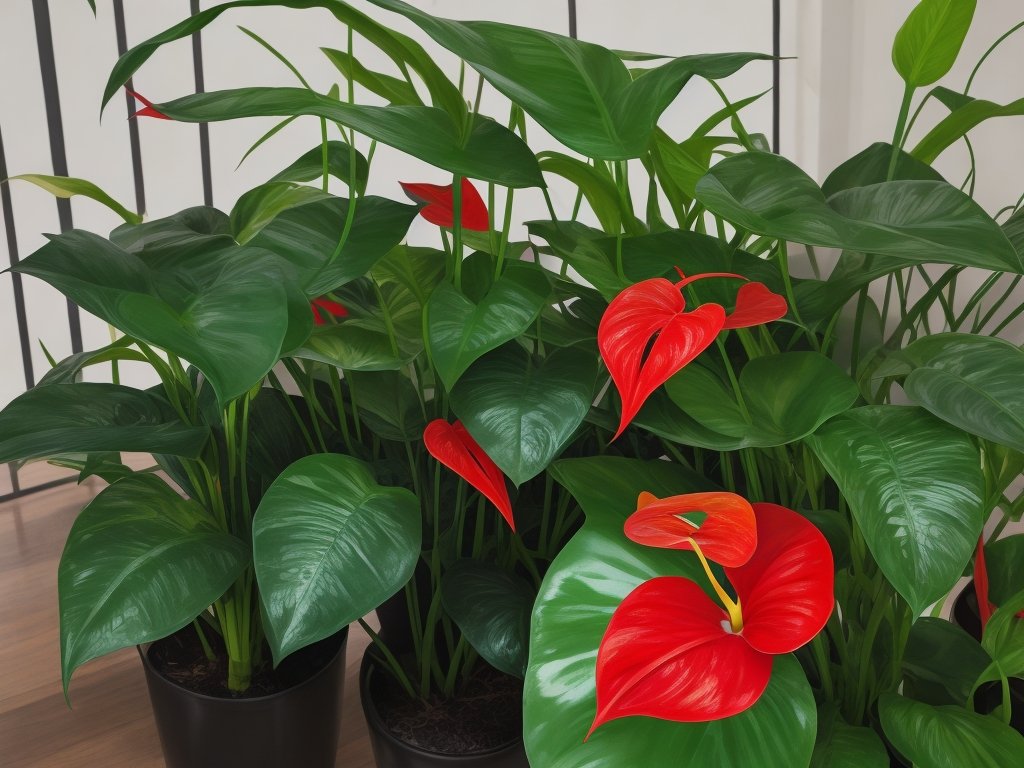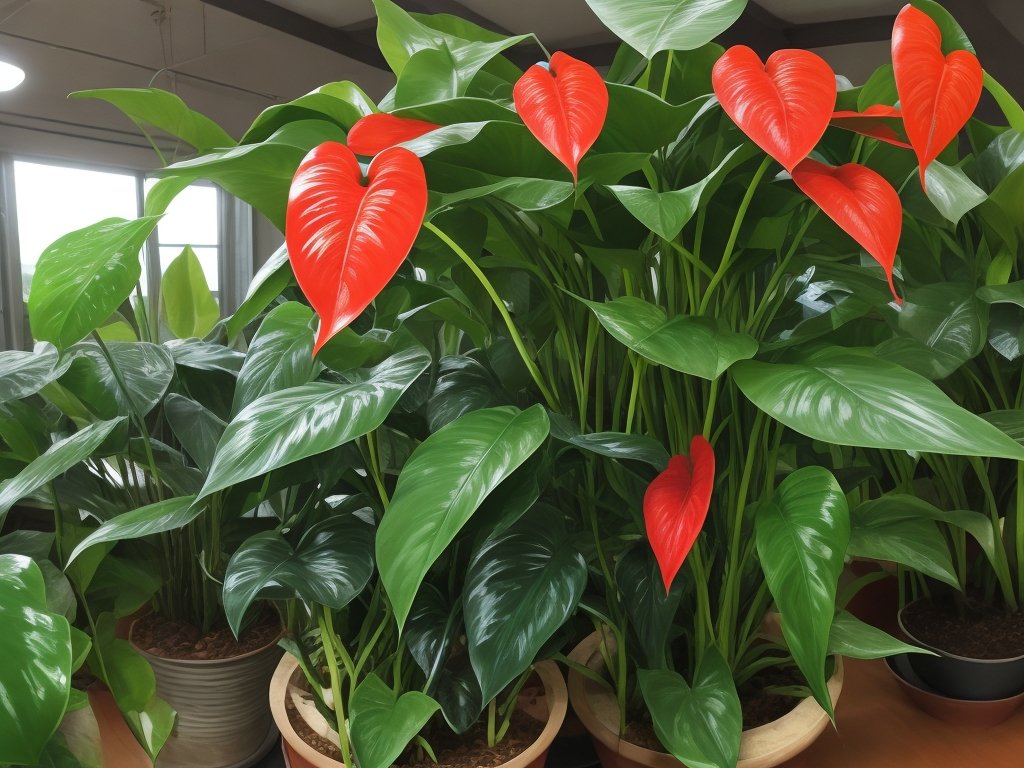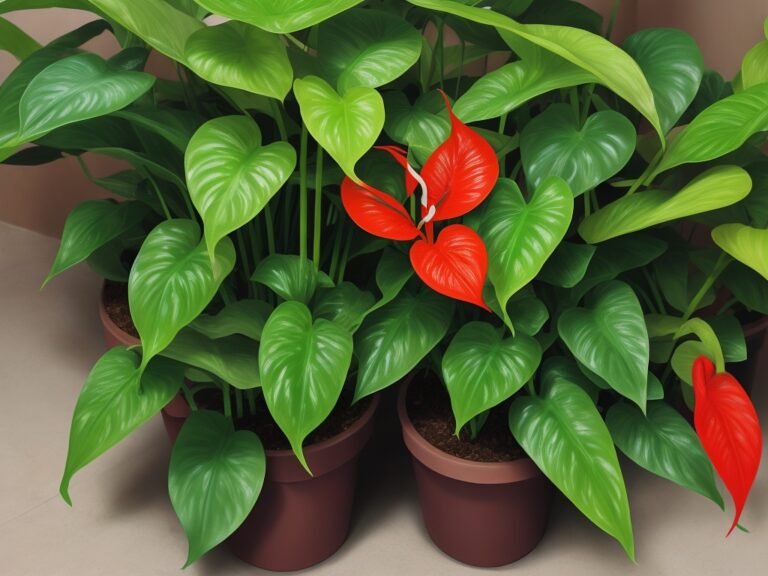Anthurium Care For Busy Individuals: Greenery Simplified!
Key Takeaways:
- Anthurium plants are low-maintenance and can thrive with minimal attention.
- Proper watering and indirect sunlight are crucial for the health of Anthuriums.
- Regularly cleaning the leaves and providing adequate humidity can prevent pest infestations.
- Anthuriums can be propagated easily through division or stem cuttings.
Are you a busy individual who loves the idea of having a beautiful houseplant but worries about finding the time to care for it? Well, say hello to the Anthurium plant! This vibrant and low-maintenance plant is the perfect companion for those with a hectic schedule.
In this blog, I will guide you through the world of Anthurium care, from choosing the right variety to troubleshooting common issues.
Get ready to bring some life into your home with these easy care tips for Anthurium plants. No green thumb required!
| Aspect | Considerations |
| Light | – Place the Anthurium in bright, indirect light – Avoid direct sunlight, as it can burn the leaves |
| Watering | – Keep the soil lightly moist, but not soggy – Water when the top inch of soil feels dry – Avoid overwatering, as it can lead to root rot |
| Temperature | – Anthurium prefers temperatures between 60 to 85°F (15 to 29°C) – Avoid placing it in areas with drafts or extreme temperature fluctuations |
| Humidity | – Anthurium enjoys high humidity, ideally around 60-70% – Mist the leaves regularly or use a humidifier |
| Fertilizer | – Use a balanced, water-soluble fertilizer – Feed every 2-4 weeks during the growing season (spring and summer) – Reduce fertilizer frequency during winter |
| Pruning | – Remove yellowing or damaged leaves – Trim back stems to maintain a compact shape – Use clean, sharp pruning shears |
| Potting | – Select a well-draining potting mix – Repot every 1-2 years or when the plant outgrows its current container |
| Pests | – Watch out for common pests like aphids, mealybugs, and spider mites – Regularly inspect the plant for signs of infestation – Treat with organic insecticidal soap or neem oil if necessary |
Anthurium Plant Overview
Anthurium plants are popular indoor houseplants known for their colorful, heart-shaped flowers and glossy, dark green leaves. With over 1000 varieties, they are relatively low-maintenance and can add a touch of tropical beauty to any space.
What is an Anthurium Plant?
An Anthurium plant is a popular indoor houseplant known for its vibrant and colorful flowers.
It has glossy, heart-shaped leaves and comes in a variety of colors, including red, pink, and white.
Anthurium plants are native to tropical regions and are known for their long-lasting blooms.
They are relatively low-maintenance and can bring a touch of tropical beauty to any space.

Anthurium Plant Varieties
Anthurium plants come in a variety of colors, shapes, and sizes. Some popular varieties include the Anthurium andraeanum, which has heart-shaped flowers in shades of red, pink, and white.
The Anthurium crystallinum is known for its velvety leaves and unique white veining.
The Anthurium clarinervium has large, dark green leaves with prominent white veins. There are also rare varieties like the Anthurium warocqueanum, which has giant leaves and a striking pattern.
These are just a few examples of the beautiful Anthurium plant varieties available for you to choose from.

Benefits of Anthurium Plants
Anthurium plants offer various benefits, making them a popular choice for indoor gardening. They not only add beauty to your space with their vibrant flowers but also improve air quality by filtering toxins.
Additionally, Anthuriums are known for their low-maintenance nature, making them perfect for busy individuals.
They are also pet-friendly, so you can enjoy their benefits without worrying about your furry friends.

Choosing the Right Anthurium Plant
When choosing an Anthurium plant, look for low-maintenance varieties that require minimal care and attention. Consider the specific needs of busy individuals when selecting an Anthurium plant, such as drought tolerance and durability.
Low-Maintenance Anthurium Varieties
Low-maintenance Anthurium varieties include the Anthurium andraeanum and the Anthurium clarinervium.
These plants require minimal care and can thrive in various indoor environments.
They have sturdy leaves, vibrant flowers, and are generally resilient to pests and diseases.
Perfect for busy individuals!
Considerations for Busy Individuals
As a busy individual, there are a few considerations you should keep in mind when choosing an Anthurium plant.
Opt for low-maintenance varieties that require less care and attention.
Make sure the plant can tolerate low-light conditions, as you may not always have time to provide ample sunlight.
Additionally, consider the watering needs and choose a variety that can withstand longer periods without water.
Lastly, research the plant’s tolerance for temperature fluctuations, as you may not always be able to control the environment.

Where to Buy Anthurium Plants
You can buy Anthurium plants at local nurseries, garden centers, or even online. Some popular online retailers for plants include Amazon, Etsy, and specialized plant websites.
Make sure to read reviews and check the seller’s reputation before making a purchase.
Understanding Anthurium Care Basics
To properly care for Anthurium plants, it’s important to understand the basics.
Light Requirements for Anthurium Plants
Anthurium plants thrive best in bright, indirect light. Avoid placing them in direct sunlight as it can scorch their leaves.
Place your Anthurium plant near a window with filtered light or use sheer curtains to diffuse the sunlight.
A minimum of 5-6 hours of bright, indirect light is ideal for their growth and flowering.
Watering and Humidity Needs
Anthurium plants prefer evenly moist soil, but be careful not to overwater.
Allow the top inch of soil to dry out before watering again.
Mist the leaves occasionally to increase humidity.
Keep the plants away from drafts and direct sunlight to avoid drying out.
Temperature and Environmental Factors
The ideal temperature range for Anthurium plants is between 60-80°F (15-26°C). They prefer a warm and humid environment, so it’s important to keep them away from drafts and extreme temperature fluctuations.
A humidity level of 50-60% is best.
Place them in a well-ventilated area with indirect or filtered light, avoiding direct sunlight which can damage their leaves. Regularly misting their leaves or placing them on a pebble tray filled with water can help increase humidity.
Easy Anthurium Care Tips for Busy Individuals
Simplified care tips for Anthurium plants that are perfect for busy people.
Proper Potting and Soil Mix
To ensure proper potting and soil mix for your Anthurium plant, you’ll want to use a well-draining potting mix that retains moisture without becoming overly soggy.
A mix of peat moss, perlite, and orchid bark works well.
Avoid heavy or clay-based soils, as these can lead to root rot.
Make sure to provide drainage holes in the pot to prevent waterlogged soil.
Additionally, it’s important to repot your Anthurium every 1-2 years to provide fresh soil and prevent overcrowding.
Regular Dusting and Cleaning
Regular dusting and cleaning is essential for keeping your Anthurium plant healthy and looking its best.
Here’s what you need to know:
- Dusting: Use a soft, damp cloth or sponge to gently wipe the leaves and remove any dust that has accumulated. Be careful not to apply too much pressure or rub too vigorously, as this can damage the delicate leaves.
- Cleaning: Occasionally, your Anthurium plant may develop sticky or dirty leaves. In this case, you can clean them by using a mild, diluted soap solution. Mix a few drops of gentle liquid soap with water, dip a cloth or sponge in the solution, and gently wipe the leaves. Rinse with clean water afterward to remove any soap residue.
- Avoid harsh chemicals: When cleaning your Anthurium plant, it’s important to avoid using harsh chemicals or cleaning products. These can be harmful to the plant and may damage the leaves or roots. Stick to gentle and natural cleaning methods to ensure the well-being of your plant.
- Frequency: Aim to dust and clean your Anthurium plant every couple of weeks or as needed. Dust can accumulate quickly, especially in indoor environments, so regular cleaning is important to maintain a clean and healthy plant.
By regularly dusting and cleaning your Anthurium plant, you’ll not only keep it looking beautiful but also create a healthier environment for it to thrive in.
Fertilizing Anthurium Plants
Fertilizing Anthurium plants is important for their overall health and growth. Use a balanced, water-soluble fertilizer with a ratio of 10-10-10 or 20-20-20.
Apply the fertilizer every two months during the growing season and use half the recommended dosage.
Avoid over-fertilizing, as it can burn the roots and harm the plant. Water the plant well after fertilizing to prevent any potential damage.
Troubleshooting Common Anthurium Care Issues
Having trouble with your Anthurium?
Here’s how to troubleshoot common care issues.
Yellowing or Browning Leaves
Yellowing or browning leaves on an Anthurium plant can be a sign of several possible issues. It could be due to underwatering, overwatering, too much direct sunlight, or even nutrient deficiencies.
To address this problem, make sure to water your plant consistently, provide the right amount of light, and check for any signs of pests.
Adjusting environmental factors like humidity and temperature can also help prevent leaf issues.
Wilting or Drooping Anthurium Flowers
Wilting or drooping Anthurium flowers are typically caused by inadequate watering or excessive sunlight. To revive your plant, make sure to water it whenever the top inch of soil feels dry.
Additionally, provide indirect sunlight or place it in a shady spot to prevent wilting.
Pest Control
Pest control is important for keeping your Anthurium plant healthy.
Here are a few tips to deal with common pests:
- Mealybugs: Remove them with a cotton swab dipped in alcohol or spray with neem oil.
- Spider mites: Rinse your plant with water or use insecticidal soap.
- Aphids: Remove them with a strong jet of water or use insecticidal soap.
- Scale insects: Scrape them off with a toothbrush or apply rubbing alcohol.
Regularly inspect your plant for signs of pests and take action immediately.
Frequently Asked Questions
How often should I water my Anthurium plant?
Water your Anthurium plant when the top inch of soil feels dry to the touch. Stick your finger into the soil to check.
It’s better to underwater than overwater, as Anthuriums are susceptible to root rot.
Aim for watering once every 1-2 weeks, adjusting based on your home’s humidity and temperature.
Do Anthurium plants require a lot of sunlight?
Anthurium plants prefer bright, indirect sunlight. They don’t require a lot of direct sunlight, as too much can burn their leaves.
Place them near a window with filtered light or in a spot with bright, indirect light.
It’s important to find a balance to ensure their growth and health.
How can I increase humidity levels for my Anthurium plant?
To increase humidity levels for your Anthurium plant, you can try a few simple methods. Firstly, you can place a humidifier near your plant to add moisture to the air.
Additionally, placing a tray of water near the plant can also help to increase humidity.
Lastly, misting the leaves of your Anthurium plant with water can provide some extra moisture.
Can I grow Anthurium plants in low-light conditions?
Yes, you can grow Anthurium plants in low-light conditions. While Anthuriums thrive in bright, indirect light, they can tolerate lower light levels too.
Just make sure to place them near a north-facing window or provide artificial grow lights to supplement the lack of natural light.
Regularly rotate the plant to ensure all sides receive equal light exposure.
Are Anthurium plants toxic to pets?
Yes, Anthurium plants are toxic to pets.
The leaves and sap contain calcium oxalate crystals, which can cause irritation and swelling in the mouth and throat if ingested.
It’s important to keep these plants out of reach of your furry friends to ensure their safety.
Final Verdict
Anthurium plants are a fantastic choice for busy individuals who want to enjoy the beauty of indoor plants without the hassle of high maintenance.
With a wide variety of low-maintenance Anthurium varieties available, finding the perfect plant for your lifestyle is easy.
By providing the right amount of light, water, and humidity, and by following a few simple care tips, you can keep your Anthurium plant thriving and looking beautiful.
Troubleshooting common care issues and being proactive in pest control will ensure your plant stays healthy.
With their vibrant flowers and air-purifying capabilities, Anthurium plants are a worthwhile addition to any busy person’s home or office.
So go ahead, bring some nature into your life and enjoy the benefits of Anthurium care!






